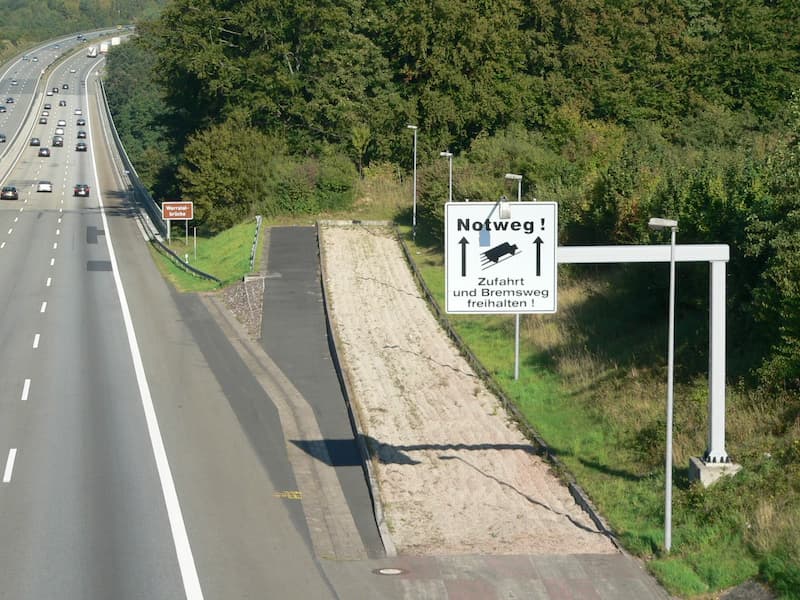Here’s the question, what is a runaway truck ramp?
A runaway truck ramp, runaway truck lane, escape lane, emergency escape ramp, or truck arrester bed is a traffic device that enables vehicles which are having braking problems to safely stop. It is typically a long, sand- or gravel-filled lane that connects to a main road’s steep downhill grade section and is made to fit big trucks or buses.
It enables the operator to safely stop a moving vehicle by allowing its kinetic energy to dissipate gradually in a controlled and relatively harmless manner.
Please continue reading so I can show you the post’s more detailed information.
The Need For Runaway Truck Ramp
Highway officials reportedly began looking for ways to reduce runaway truck accidents sometime in the 1960s. Prior to 1980, there isn’t much information available. However, according to a NHTSA report, runaway truck incidents totaled 2450 in 1981. Those statistics show that heavy-duty trucks speed recklessly more frequently than the majority of people might think.
The problem is that a semi cannot downshift to control its speed when traveling down a steep grade because of the non-synchronized transmission. In that circumstance, the truck can only be slowed down using its brakes. The brake system, however, is under a lot of pressure when the vehicle is fully loaded—about 80,000 pounds of pressure, in fact. The issue of brake fade is made worse by increasing speed on a incline. When the brakes completely fail for some drivers, the situation quickly spirals out of their control.
Types Of Runaway Truck Ramps
So how do you stop a runaway rig? In the event that the semi brakes fail, it makes sense to use the reverse gear since gravity is usually to blame. Gravity escape ramps are steep gravel ramps that run off and up at the side of the road near the bottom of a steep decline.” The runaway truck ramp that is most frequently used in mountainous areas is this one. The truck can be stopped quickly thanks to the gravel and the steep rise.
Various variations of runaway truck ramps include:
Sand pile ramps—used on less steep grades, a series of sand piles placed on a short ramp help stop speeding trucks
Arrester bed ramps—a short ramp covered with gravel used on minimal grade slopes
Mechanical-arrester ramps—stainless-steel nets stretched across the road near the beginning of the ramp. This design is comparable to the idea applied on aircraft carriers to aid in preventing planes from landing.
Not every ramp is incline. Some people run alongside the road on nearly level ground. Others jog toward the median. Additionally, runaway truck ramps frequently have concrete barriers running along the sides. They provide additional assistance for stopping and keeping the truck upright and help keep out-of-control trucks on the ramp. As you might expect, using a runaway truck ramp can have negative effects. Furthermore, even if the vehicle doesn’t topple over after coming to a stop, there is no other way to remove a truck from the ramp than with a tow. See more about What Is Payload On A Truck?

Location Of Runaway Truck Ramp
Emergency exit ramps are typically situated on sustained grades that are steep, like in mountainous areas. High vehicle speeds may be possible at the bottom of long descents, and repeated use of truck brakes may cause them to overheat and fail. The ramps are frequently constructed before a significant change in the radius of the curve of the road or before a location where the vehicle may need to stop, such as before an intersection in a densely populated area. The selection standards can differ from one area/nation to another. See more about What Is A Straight Truck?
Why Do Runaway Truck Ramps Exist?
Losing Control
Trucks carrying a full load are more propelled by their weight. Trucks frequently pick up speed quickly when traveling downward. Truck drivers with experience do this to increase resistance and control the speed increase by shifting into low gear.
The issue arises if the truck is moving too quickly when it begins to descend. When that occurs, it will only accelerate further and quickly reach dangerous speeds. This is particularly challenging on hills because the truck needs more power to ascend but then must quickly slow down before beginning to descend the opposite side.
A truck driver may attempt to apply the brakes when faced with an overly fast truck. However, the brakes will stop working once the car picks up enough speed. Furthermore, if a truck driver panics and slams on the brakes, the truck may slow down, but the trailer will continue to advance, possibly causing the truck to “jackknife” and rollover.
Because they involve a speeding truck and have the potential to hit multiple vehicles, runaway truck crashes frequently result in catastrophic damage.
Controlled Stop
Ramps are the solution to the issue of runaway trucks. Many inclines on American roads. have a special ramp that is meant to reduce the truck’s momentum and bring the vehicle to a halt as quickly as possible.
Runaway truck ramps come in a variety of forms, but the most typical is a steep mound of sand or gravel. These cause a lot of friction, which slows the car down, and are steep enough to prevent the truck from moving forward by climbing the ramp.
While runaway truck accidents are uncommon, it’s crucial that all drivers are aware of this risk and watch out for nearby trucks, especially when going downhill.
The End
They are also known as “truck escape ramps” or “escape bays” in Britain. They use gravel or sand to add extra friction and typically an incline to slow moving vehicles down. Instead of ramps, aircraft carrier-style arresting cables with netting have been used, but they require more upkeep.
The ramps first appeared, appropriately in mountainous areas, sometime in the middle of the 1960s, though no one seems to be able to pinpoint exactly when or where that happened.
